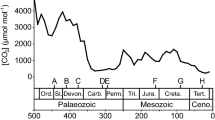Summary.
A double-wall map L-system, designated as S5-5, was developed to simulate the cellular pattern found at the summit of shoot apices of Psilotum nudum. Commencing from a 3-sided autoreproductive founder cell, fives steps of simulation established a basic set of ten different cell types. Continuing the simulation beyond the fifth step revealed that, in addition to the regular production of new 3-sided cells, a group of autoreproductive 5-sided cells came into being. A close correspondence exists between the cells of the two-dimensional simulation and the two-dimensional cellular patterns found on the epidermis of the apices of Psilotum species. The 3-sided cells produced during the simulation correspond to the potentially organogenetic 3-sided cells that can be seen upon the apical surfaces. Successive generations of these 3-sided apical cells (which are actually 4-sided tetrahedral cells when viewed in three dimensions) and their immediate descendants are thought to be selected to organise the successive pairs of apices that bring about the repeated bifurcation of the Psilotum shoots. The 5-sided cells contribute to the cellular “pavements” which separate these pairs of organogenetic centres, each with their 3-sided apical cells. The cellular patterns simulated by the S5-5 system may also correspond to the cellular patterns found on the surfaces of some other pteridophyte apices, including that of the rhizophores of Selaginella species. Tritiated-thymidine labelling of rhizophore apices revealed a group of nonproliferating cells that was associated with rhizophore bifurcation and which may correspond to a group of pavement cells. Nonproliferating cells, by regulating the siting of new organogenetic centres, may have evolved as an accompaniment to branching events such as the bifurcation of root and organ axes.
Similar content being viewed by others
Author information
Authors and Affiliations
Additional information
Correspondence and reprints: School of Biological Sciences, University of Bristol, Woodland Road, Bristol BS8 1UG, United Kingdom.
Rights and permissions
About this article
Cite this article
Barlow, P., Lück, J. Deterministic cellular descendance and its relationship to the branching of plant organ axes. Protoplasma 224, 129–143 (2004). https://doi.org/10.1007/s00709-004-0063-5
Received:
Accepted:
Published:
Issue Date:
DOI: https://doi.org/10.1007/s00709-004-0063-5




